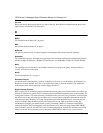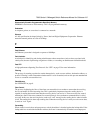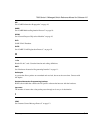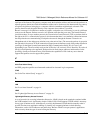
7000 Series L3 Managed Switch Reference Manual for Software v2.0
C-8 Glossary
198.105.232.4. The DNS system is, in fact, its own network. If one DNS server doesn't know how to
translate a particular domain name, it asks another one, and so on, until the correct IP address is returned.
Domain Name
A descriptive name for an address or group of addresses on the Internet. Domain names are of the form of a
registered entity name plus one of a number of predefined top level suffixes such as .com, .edu, .uk, etc. For
example, in the address mail.NETGEAR.com, mail is a server name and NETGEAR.com is the domain.
DSL
Short for digital subscriber line, but is commonly used in reference to the asymmetric version of this
technology (ADSL) that allows data to be sent over existing copper telephone lines at data rates of from 1.5
to 9 Mbps when receiving data (known as the downstream rate) and from 16 to 640 Kbps when sending data
(known as the upstream rate).
ADSL requires a special ADSL modem. ADSL is growing in popularity as more areas around the world
gain access.
DVMRP
See “Distance-Vector Multicast Routing Protocol.” on page 7.
Dynamic Host Configuration Protocol.
DHCP is a protocol for assigning dynamic IP addresses to devices on a network. With dynamic addressing,
a device can have a different IP address every time it connects to the network. In some systems, the device's
IP address can even change while it is still connected. DHCP also supports a mix of static and dynamic IP
addresses. Dynamic addressing simplifies network administration because the software tracks IP addresses
rather than requiring an administrator to manage the task. A new computer can be added to a network
without the hassle of manually assigning it a unique IP address.
E
EAP
Extensible Authentication Protocol is a general protocol for authentication that supports multiple
authentication methods. EAP, an extension to PPP, supports such authentication methods as token cards,
Kerberos, one-time passwords, certificates, public key authentication and smart cards. In wireless
communications using EAP, a user requests connection to a WLAN through an AP, which then requests the
identity of the user and transmits that identity to an authentication server such as RADIUS. The server asks
the AP for proof of identity, which the AP gets from the user and then sends back to the server to complete
the authentication. EAP is defined by RFC 2284.
EEPROM
See “Electronically Erasable Programmable Read Only Memory” on page 9.


















